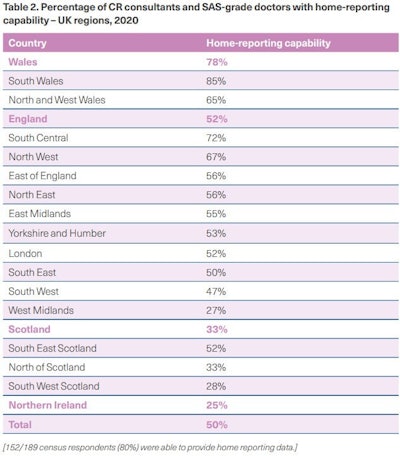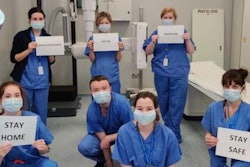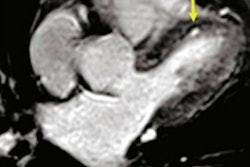
The U.K. radiologist workforce is now short-staffed by 33% and needs at least another 1,939 consultants to meet safe staffing levels and pre-COVID-19 levels of demand for scans, according to a new census published on 28 April by the U.K. Royal College of Radiologists (RCR).
Around 58% of radiology clinical directors say they do not have enough radiologists to keep patients safe, and 47% of National Health Service (NHS) trusts and health boards do not have the staff or transfer arrangements needed to run safe 24/7 interventional radiology services.
"Without more consultants in training, investment in new models of care and better staff retention and recruitment, by 2025 the UK's radiologist shortfall will hit 44% (3,613 consultants short of real terms demand)," noted the authors of the 70-page document, "Clinical radiology UK workforce census 2020 report."
There were 4,277 clinical radiology consultants, 1,760 specialty trainees, and 86 specialty and associate staff (SAS)-grade doctors in post in September 2020, and the U.K. radiology workforce has grown by 5% over the past year, the authors wrote. The 7% increase in radiology trainees reflects both a 5% increase in doctors starting training over the past year and a reduced number of trainees completing their training.
Effect of COVID-19 pandemic
As of September 2020, 370,000 people in England alone were waiting for CT or MRI examinations, of whom nearly a quarter (23%) -- 84,000 people -- had been waiting for six weeks or more. By comparison, in September 2019, far fewer people -- 9,000 or 3% of the waiting list (totaling 328,000) -- had been waiting six or more weeks.
 Dr. Giles Maskell.
Dr. Giles Maskell.The pandemic has brought into sharp relief the preexisting deficiencies in radiology staffing and equipment in the NHS, Dr. Giles Maskell, past president of the RCR, told AuntMinnieEurope.com.
"As concerns rise over NHS waiting lists for surgery, it has become ever clearer that our healthcare system as a whole cannot function without a properly funded imaging service," he said. "The requirement for investment which was desperately needed before COVID has now become even more urgent."
Another observer speaks in blunt terms about the difficulties facing U.K. radiology.
"This is a slow-motion train crash," said a senior consultant radiologist who did not wish to be named. "It is a case of 'same old' in the respect that it's been going on for 20 years. The RCR back then projected the shortfall, looking at historical growth of the speciality. Unfortunately they have been proved wrong. The shortfall has been much worse as radiology has grown more than predicted."
The RCR has been smart in documenting the "train crash" in minute detail and publicizing the situation, but its evidence of a deepening crisis has been totally ignored by Health Education England (HEE), with paltry increases in training numbers in the last decade, the source continued.
"The situation is worse than expected because of two factors. First, the pandemic has clearly put stress on a stressed system. But in the background, there has been an overall pay cut of 30% in the last decade, through pay freezes and below-inflation pay rises and steady assaults on NHS pensions with punitive tax regimes for senior consultants," the radiologist said.
This has led to a mass exodus of radiologists over 55, and plans to recruit overseas radiologists have met with modest success, the source noted. The combination of spiraling workload, inability to recruit, and disillusioned and angry radiologists is leading to a perfect storm, particularly in less high-profile hospitals where services are fragmented.
Working at home
For the first time, the RCR's annual report contained detailed information about home reporting. In September 2020, half of U.K. clinical radiology consultants and SAS doctors had home-reporting capability, but the picture varied significantly across nations and regions, the authors wrote.
Around 78% of consultant and SAS-grade radiologists in Wales had home-reporting capability in September 2020, compared with only 25% in Northern Ireland. The full picture is shown in the table below.

The RCR report refers to several radiology clinical directors who have flagged the lack of funding, information technology (IT) support, and senior-level support as barriers to the rollout of homeworking. For example, "We are having difficulty persuading the senior management of the benefits and difficulty identifying funding for workstations."
Clinical directors have indicated huge variability in homeworking practices, with some hospital groups and health boards using it for on-call work only, while consultant radiologists elsewhere have worked from home two to three days per week. A wide range of comments were received by the RCR, including the following:
- "The disadvantage has been the impact on training and accessibility of radiologists."
- "Not good for general morale, not good for trainees."
- "Needs to be managed closely with the directorate policy regarding needs, expectations, and 'eligibility.' "
- "Success during COVID-19 but should be used responsibly as departmental presence is required."
- "Awaiting installation of new PACS later this year to facilitate home reporting."
- "Network speeds and computing problems at home [are] difficult to fix easily."
- "The connection and speed were poor and sometimes impossible."
- "The IT department has been unable to resolve voice recognition issues and, as such, have not rolled-out home reporting."
Other senior radiologists are more positive, however. They note that home reporting provides an improved work-life balance for radiologists, attracts new appointments, saves space in hospitals, and prevents infection. It has helped with insourcing, thereby decreasing the amount of cash spent on outsourcing. It provides flexibility to attract radiologists from outside the catchment area, and it allows for a 24/7 service and is really popular and increases productivity, others said.
Looking to the future
Overall, the census reveals huge shortages across radiology departments, and without additional funding, patient care will be further compromised, Prof. Mark Callaway, radiology workforce lead at the RCR, wrote in a foreword to the document.
"Our new report has found the NHS needs thousands more radiologists to ensure patients get the safe and effective treatment they deserve, amplified by the first-hand experience of frontline doctors who witness the impact of consultant shortages on patient care on a daily basis," he noted. "The staffing forecast for 2025 makes grim reading, but, even more worryingly, swathes of demoralised radiologists are imminently looking to work less or leave the NHS."
"Our census is not an opinion piece; not a light piece of research. It is a robust document in which every single trust and health board in the UK has participated. Why? Because this is an urgent issue that needs to be tackled. Many lives are at stake if it is not," Callaway wrote.
Editor's note: For full details about the new report and to download a free copy, go to the RCR website. This annual workforce report builds on the interim report published by the RCR in August 2020. A follow-up article on the recruitment section of the new RCR annual report will follow soon on AuntMinnieEurope.com. Also, for detailed analysis of the situation in Wales, see the news piece posted by the BBC on 28 April 2021.



















